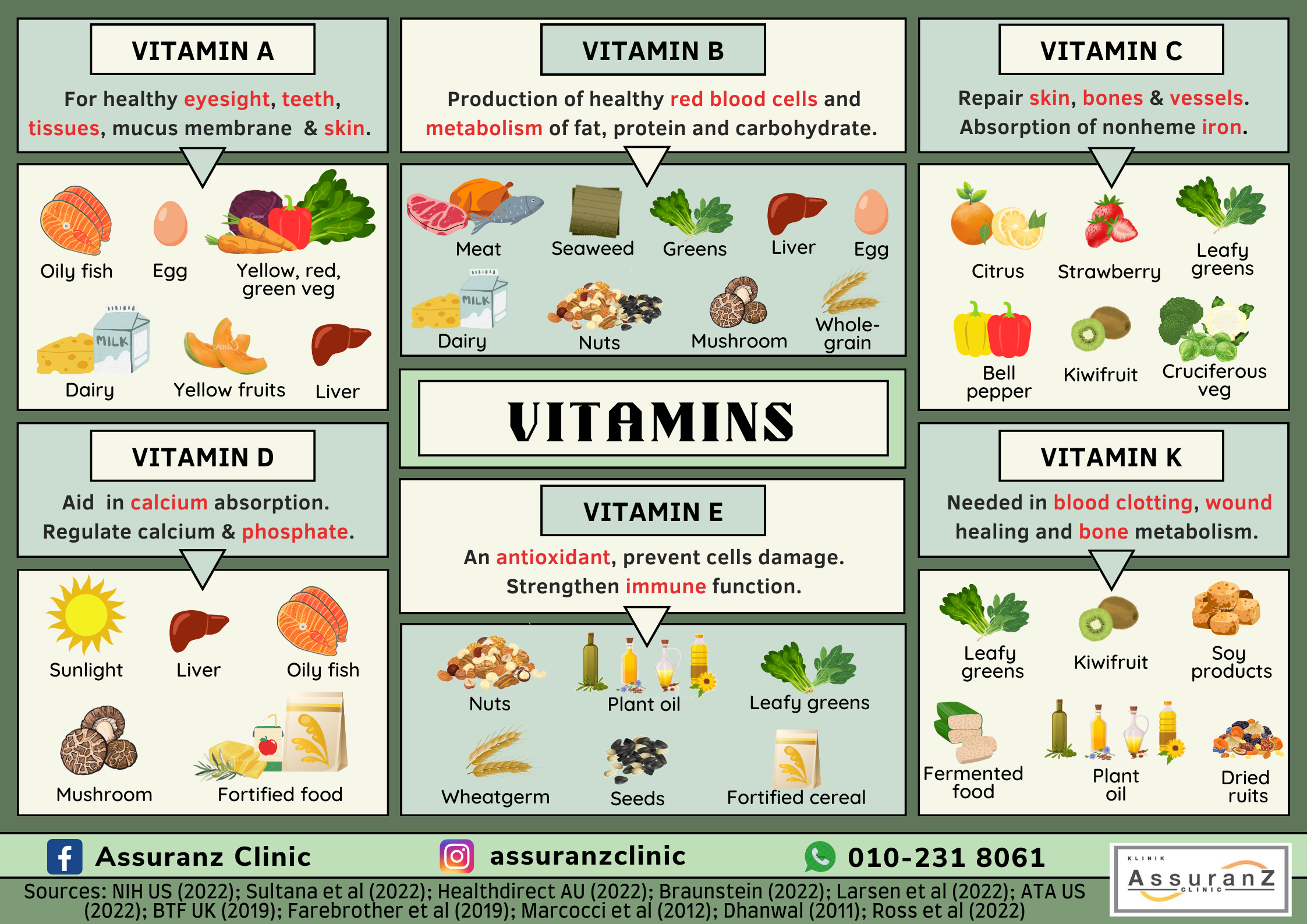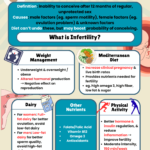Most of us are well informed that consuming adequate vitamins can help in optimizing our health. But do you know what exactly is vitamin? Vitamins are micronutrients, meaning that they are nutrients needed by the body in small amount. However, they have crucial roles in many biochemical functions, with deficiency causing severe and, in some cases, life-threatening conditions. Vitamins can be divided into two main groups – fat-soluble (easily stored in fat upon absorption) and water-soluble (dissolve in water and are not easily stored).
大多数人都知道摄入足够的维生素有助于优化我们的健康。但是您知道维生素到底是什么吗?维生素是微量营养素,也就是说它们是人体所需的少量营养素。然而,它们在许多生化功能中起着至关重要的作用,缺乏会导致严重的,在某些情况下甚至危及生命的情况。维生素可分为两大类——脂溶性维生素(吸收后容易储存在脂肪中)和水溶性维生素(溶于水且不易储存)。
Water-soluble (Vitamin B & C)
水溶性维生素(维生素B和C)
– Vitamin B / 维生素B
Vitamin B consists of vitamin B1 (thiamine), B2 (riboflavin), B3 (niacin), B5 (Pantothenic acid), B6 (Pyridoxine), B7 (Biotin), B9 (Folate) and B12 (Cobalamin). The major function of vitamin B6, B9 and B12 is to work with iron to make healthy red blood cells. This is important as red blood cells carry and distribute oxygens to our organs. Inadequacy can result in anaemia (not enough red blood cells). Vitamin B9 and B12 is common, normally affecting certain population such as pregnant or lactating mother and elderly. Isolated vitamin B6 deficiency is not common, and usually is associated with vitamin B9 and B12 deficiency.
维生素B由维生素B1(硫胺素)、B2(核黄素)、B3(烟酸)、B5(泛酸)、B6 (吡哆醇)、B7(生物素)、B9(叶酸)和 B12(钴胺素)组成。维生素B6、B9和B12的主要功能是与铁一起制造健康的红细胞。这很重要,因为红细胞携带氧气并将其分配给我们的器官。维生素B的不足会导致贫血(红细胞不足)。很常见的维生素B9和B12通常会影响某些人群,例如孕妇或哺乳期母亲和老年人。维生素B6缺乏症并不常见,通常与维生素B9和B12缺乏症有关。
On the other hand, vitamin B1, B2, B3, B5 and B7 aids in metabolism of fat and carbohydrate and protein to provide energy for our body. Severe deficiency can cause diseases such as beriberi and pellagra. However, deficiency is uncommon.
另一方面,维生素B1、B2、B3、B5和B7有助于脂肪、碳水化合物和蛋白质的新陈代谢,为我们的身体提供能量。严重缺乏会引起脚气病、糙皮病等疾病。然而,缺乏这些维生素并不常见。
Good vitamin B1 sources include peas, fruits, nuts, wholegrain bread, and liver. Vitamin B2 rich food include dairy products, egg and mushrooms, while B3 is abundant in meat, fish, wheat flour and egg. Vitamin B5 and B6 is found in wide variety of vegetables, wholegrain foods, and meat. Vitamin B7 is naturally produced by the bacteria in our gut. High vitamin B9 food includes green and leafy vegetables, peas, beans, nuts, seeds, and liver. Vitamin B12 sources are mainly from animal sources, which are meat, fish, dairy products, and eggs. Vegan B12 sources include mushrooms, seaweed, nutritional yeasts and fortified food.
良好的维生素B1来源包括豌豆、水果、坚果、全麦面包和肝脏。富含维生素B2的食物包括乳制品、鸡蛋和蘑菇,而维生素B3则富含于肉类、鱼类、小麦粉和鸡蛋中。维生素B5和B6存在于多种蔬菜、全麦食品和肉类中。维生素B7是由我们肠道中的细菌自然产生的。富含维生素B9的食物包括绿色和多叶蔬菜、豌豆、豆类、坚果、种子和肝脏。维生素B12的来源主要来自动物,即肉类、鱼类、乳制品和蛋类。纯素B12来源包括蘑菇、海藻、营养酵母和强化食品。
– Vitamin C / 维生素C
Vitamin C is needed to repair and maintain healthy skin, bones, joints, and blood vessels. It also is important in wound healing. It plays a vital role in the production of collagen and helps limit the damaging effect of free radicals as it acts as an antioxidant. Vitamin C also aids the absorption of nonheme iron (Iron obtained from plant-based food) and contributes to the immune system by helping the white blood cells function more effectively. Inadequacy of vitamin C can lead to scurvy, which among the symptoms include fatigue, connective tissue weakness and easy bruising.
我们需要维生素C来修复和维持健康的皮肤、骨骼、关节和血管。它在伤口愈合中及胶原蛋白的生产中起着至关重要的作用,并有助于限制自由基的破坏作用,因此它可充当抗氧化剂。维生素C还有助于吸收非血红素铁(从植物性食物中获取的铁),并帮助白细胞更有效地发挥作用来增强免疫系统。维生素C不足会导致坏血病,其症状包括疲劳、结缔组织无力和容易瘀伤。
Vitamin C can be found in various fruit and vegetables, but is most abundant in citrus fruits, tomatoes, bell peppers, berries, kiwifruits, potatoes (especially if eaten with skin), cruciferous vegetables (such as broccoli), green and leafy vegetables.
维生素C存在于各种水果和蔬菜中,但在柑橘类水果、西红柿、甜椒、浆果、奇异果、土豆(尤其是带皮食用)、十字花科蔬菜(如西兰花)、绿色和多叶蔬菜中含量最高。
Fat-soluble (Vitamin A, D, E & K)
脂溶性维生素(维生素A,D,E和K)
– Vitamin A / 维生素A
Vitamin A in our diet can be categorised into two, preformed vitamin A (animal sources) and provitamin A (plant sources, converted into vitamin A in the intestine). Vitamin A promotes good eyesight especially in darkness, as well as aiding in formation and maintenance of healthy teeth, skeletal and soft tissue, mucus membrane and skin. Deficiency, while uncommon, can cause eye condition namely xerophthalmia which, if untreated, can lead to blindness.
我们饮食中的维生素A可分为两种,预先形成的维生素A(动物来源)和维生素原A(植物来源,在肠道中转化为维生素A)。维生素A可促进良好的视力,尤其是在黑暗中,并有助于形成和维持健康的牙齿、骨骼和软组织、粘膜和皮肤。缺乏维生素A虽然不常见,但会导致眼部疾病,即干眼症,如果不及时治疗,可能会导致失明。
Preformed vitamin A is found in oily fish (such as herring and salmon), organ meats (also high in cholesterol, and unsafe for pregnancy), dairy products, eggs, and fortified food (such as spreads and breakfast cereal). Provitamin A sources include yellow, orange, purple and red vegetables or fruits, and leafy greens.
预先形成的维生素A存在于油性鱼类(如鲱鱼和鲑鱼)、内脏肉(胆固醇含量也很高,对怀孕不安全)、乳制品、鸡蛋和强化食品(如涂抹酱和早餐麦片)中。维生素A原来源包括黄色、橙色、紫色和红色蔬菜或水果,以及绿叶蔬菜。
– Vitamin D / 维生素D
Vitamin D in food comes in two main forms, D2 and D3. Although some research shows that Vitamin D3 is more efficient in increasing our body’s serum vitamin D than D2, both forms are absorbed well. Vitamin D functions to promote calcium absorption in the intestines, regulation of serum calcium and phosphate for normal bone mineralization. Inadequacy of vitamin D affects bone strength, leading to fractures and diseases such as rickets, osteomalacia and osteoporosis.
食物中的维生素D主要有两种形式,D2和D3。虽然一些研究表明维生素D3比D2更能有效地增加我们身体的血清维生素D,但两种形式都被很好地吸收了。维生素D的作用是促进肠道对钙的吸收,调节血清钙和磷酸盐以促进正常的骨矿化。维生素D不足会影响骨骼强度,导致骨折和疾病,例如佝偻病、骨软化症和骨质疏松症。
Our skin exposure towards ultraviolet (UV) rays from direct sunlight can trigger vitamin D synthesis. However, the production rate varies according to location, clothing, sunscreen use, skin pigmentation, age, and obesity. Vitamin D is also found in some food, including
oily fish, liver, egg yolk, mushrooms and fortified food such as dairy products, soft spread, breakfast cereal, orange juice and soy drink.
我们的皮肤暴露于直射阳光下的紫外线(UV)会触发维生素D的合成。然而,生产率因地点、衣服、防晒霜使用、皮肤色素沉着、年龄和肥胖而异。维生素D也存在于一些食物中,包括油性鱼、肝脏、蛋黄、蘑菇和强化食品,如乳制品、软涂抹酱、早餐麦片、橙汁和大豆饮料。
– Vitamin E / 维生素E
Vitamin E is an antioxidant. It prevents free radicals (which can cause diseases such as heart disease and cancer) from damaging the cells. Vitamin E also partakes in strengthening the immune function. Vitamin E deficiency is rare. However, one might experience symptoms such as peripheral neuropathy, muscle weakness and incoordination, retinopathy, and impairment of the immune response in case of severe inadequacy.
维生素E是一种抗氧化剂。它可以防止自由基(可导致心脏病和癌症等疾病)破坏细胞。维生素E还参与增强免疫功能。维生素E缺乏症很少见。然而,在严重不足的情况下,可能会出现周围神经病变、肌肉无力和不协调、视网膜病变以及免疫反应受损等症状。
Vitamin E comes in several forms, but only alpha tocopherol is used in human. The sources of vitamin E include nuts, seeds, plant oils (such as rapeseed, sunflower, and corn oil), leafy greens, wheatgerm and fortified cereals.
维生素E有多种形式,但只有α-生育酚用于人体。维生素E的来源包括坚果、种子、植物油(如油菜籽、向日葵和玉米油)、绿叶蔬菜、小麦胚芽和强化谷物。
– Vitamin K / 维生素K
Vitamin K helps in blood clotting and wound healing. It is also needed in bone metabolism. There are three types of vitamin K, which are K1, K2 and K3. Vitamin K1 is the primary dietary form of vitamin K, while vitamin K2 is mainly of bacterial origin. Vitamin K3 is synthetic vitamin K, normally found as dietary supplement. Severe deficiency of vitamin K leads to bleeding and haemorrhage (including bruising). It can also lead to poor bone health.
维生素K有助于血液凝固和伤口愈合。骨代谢也需要它。维生素K可分为三种,分别是K1、K2和K3。维生素K1是维生素K的主要膳食形式,而维生素K2的主要来源于细菌。维生素K3是合成维生素K,通常作为膳食补充剂使用。严重缺乏维生素K会导致出血,包括瘀伤。它还可能导致骨骼健康状况不佳。
The sources of vitamin K include green and leafy vegetables, plant oils, soy products and some fruits (kiwifruit, dried fruits et cetera). Fermented food such as natto, cheese and tempeh are also good vitamin K sources. Vitamin K can reduce the effectiveness of blood thinning medication (warfarin), therefore those who are on the medication should talk to the healthcare provider on their vitamin K intake.
维生素K的来源包括绿色和多叶蔬菜、植物油、豆制品和一些水果(奇异果、干果等)。纳豆、奶酪和豆豉等发酵食品也是维生素K的良好来源。维生素K会降低血液稀释药物(华法林)的有效性,因此服用药物的人应就维生素K的摄入量向医疗保健提供者咨询。
While vitamins are important for normal bodily function, adequate amount can be obtained through our dietary intake (except for certain cases such as pregnancy, veganism, and malabsorption), as long as we include a variety of food sources in our meal. Supplementation, in excess, might even cause toxicity especially for fat soluble vitamins, leading to symptoms such as nausea, headache and mental changes. Some vitamin absorption can be affected by caffeine, alcohol, smoking and certain medications. Therefore, if you consume any of these, be sure to have a gap of at least 30 minutes before or after taking your healthful meals.
虽然维生素对正常的身体机能很重要,但只要我们在膳食中包含多种食物来源,我们就可以通过饮食摄入足够的量(某些情况除外,例如怀孕、素食主义和吸收不良)。过量补充甚至可能引起毒性,尤其是脂溶性维生素,它将会导致恶心、头痛和精神变化等症状。一些维生素的吸收会受到咖啡因、酒精、吸烟和某些药物的影响。因此,如果您食用其中任何一种,请确保在进食健康膳食之前或之后至少间隔30分钟。






